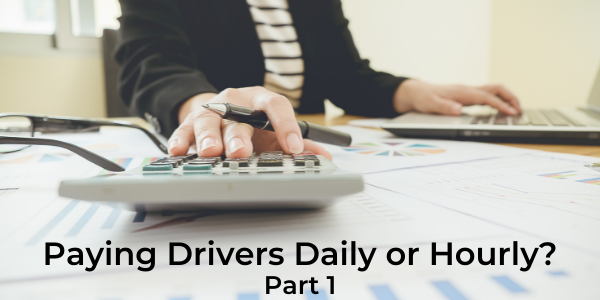
This post is the first in a series on choosing to pay drivers by the hour, or by the day.
Almost every week, another new Contractor will ask me an old question. Should I pay my drivers hourly, or by the day? There’s truly one right answer, but complex dynamics cause many new CSP’s to believe that the old ways of paying drivers are acceptable.
Many new Contractors do not bring transportation industry experience with them. Although it’s likely they achieved significant success in their previous ventures. That success can lead to a variety of ways they address driver compensation.
New Contractors typically choose to either keep the same practices as the previous owner, or they make drastic changes. If they choose the latter, it’s because they recognize the existing compensation method is not financially feasible.
Why It Matters
You may ask, “Why does it really matter how I pay my drivers?” Two dynamic factors answer that question.
- Your compensation method is subject to the labor laws of the state in which you operate. Examples include minimum wage, overtime laws, etc.
- You’re contractually required to successfully meet the review of a FedEx Ground (FXG) labor audit. Plus, it impacts your ability to negotiate in the future.
In order to meet the first point, your payment method must equal a minimum wage that equates, or exceeds, the hourly minimum wage in your state.
You also must compensate for overtime hours. You need to understand your state’s overtime laws, i.e. 40+ hours in a week vs 8+ hours on a given day.
In regards to the second point, FXG will be auditing several factors:
- How do you track your drivers’ time? Your time tracking method must be independent of FXG and the data they provide to track driver attendance and hours worked. Unacceptable methods include scanner reports and DSW reports from MGB. In short, you cannot use data provided by FXG to document driver attendance and hours worked.
- Any person driving a vehicle in your fleet that is less than 10,001 lbs. GVW must be compensated hourly for the pay week during which they operated that vehicle. This is true regardless of how briefly driven. Can you provide a history of who operated which vehicles on which days? Hourly pay must meet applicable state overtime and minimum wage guidelines. Again, CSP’s are responsible for tracking that information.
- Any driver operating a vehicle, or vehicles, exceeding 10,001 lbs. GVW for an entire pay period may be paid on a daily rate, or hourly rate, as long as state minimum wage requirements are met. Once again, the hours a driver operated and worked are key data elements that need to be documented outside of FXG data.
Let’s now look further at some of the specifics and tendencies of both payment methods.
Daily Pay
By paying a set figure for a work day to a driver, you have created a fixed cost. Your labor cost is known before the day begins; however, it causes several negative, unintended consequences for your business.
- It is difficult to reduce your labor costs to match “less than expected” volume.
- Drivers are now “guaranteed” a day’s pay. This may result in drivers completing less stops. They may, in fact, end their work day early since they will not experience personal financial impact by working less hours.
- Drivers may develop a false sense of stop capacity for “their” route which is lower than ownership expects, or needs, to achieve profitability.
- By working less hours daily (as mentioned previously) even though a driver is paid daily, it may inflate what a driver calculates, or “feels,” their hourly rate of pay would be. For example:
- A driver's average pay is $150/day. If you were asked to determine an hourly rate, you may be inclined to compute it as $150/8 Hrs = $18.75/Hr.
- If a driver who averages 6 Hrs/day on duty is asked that question, they most likely will think they earn $25.00/Hr. ($150/6 Hrs).
- An imbalance in understanding will exist between ownership and drivers.
 The very reason managers prefer this method is problematic. Paying by the day tends to lose focus on how efficient a driver is performing on the road.
The very reason managers prefer this method is problematic. Paying by the day tends to lose focus on how efficient a driver is performing on the road.
Since this driver “cost” is expected, management does not focus on achieving optimal staffing. The focus is only that all scheduled drivers are on road.
Symptoms include:
- A decline in drivers’ hours on road per day.
- Stops per dispatch decrease.
- Increased stops for the business causes drivers to request additional on road help. This results in management going on road routinely, and the need for additional vehicles.
Hourly Pay

Paying by the hour requires that management is constantly monitoring and assessing driver performance and expectations, which is something they should be doing as part of operating an efficient business. Benefits from operating this way include:
- First and foremost, you are able to match your labor to the stop demands you are experiencing on a daily basis vs overstaffing - just in case.
- You will need to focus on each driver individually. This will result in greater efficiency from each driver. Schedules are based on daily needs.
- FedEx Ground labor audits and any State Department of Labor inquiries are quickly and easily answered.
This business experiences daily variable workload (changing stops). In order to effectively manage a labor intensive, last mile delivery business, your labor cost must be variable, not fixed. Paying by the hour affords you that flexibility.
End of Part 1 in the series.
